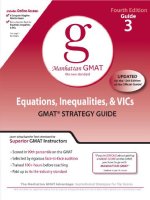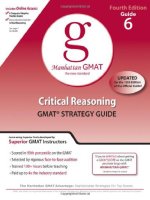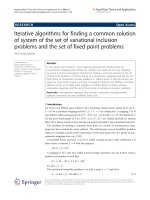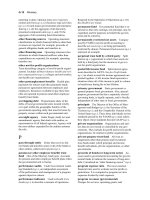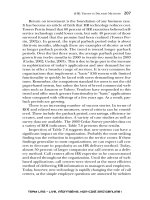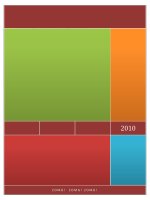Prep manhattan GMAT set of 8 strategy guides 06 the critical reasoning guide 4th edition
Bạn đang xem bản rút gọn của tài liệu. Xem và tải ngay bản đầy đủ của tài liệu tại đây (3.94 MB, 190 trang )
Includes
Online Access:
~ 6 Computer Adaptive
Practice Exams
~
Bonus Question Bank for
Critical Reasoning
Seepage 7
for details.
9rlanliattan GMAT
the new standard
Learn using Superior Tools developed by
Superior GMAT Instructors
• Scored in 99th percentile on the GMAT
• Selected by rigorous face-to-face audition
•Trained 100+ hours before teaching
• Paid up to 4x the industry standard
The Manhattan GMAT Advantage:
"If you're SERIOUS about getting
a GREATSCOREon the GMAT,
you have to go with
MANHATTAN GMAT.11
- Student at top 5 b-school
Sophisticated Strategies For Top Scores
GMAT and GMAC are registered trademarks of the Graduate Management Admission Council which neither sponsors nor endorses this produc.
:M..anliattanG MAT'Prep
the new standard
1. ARGUMENT STRUCTURE
11
. In Action Problems
Solutions
21
25
27
2. DIAGRAMMING
In Action Problems
Solutions
37
41
3. GENERAL STRATEGY
45
4. FIND THE ASSUMPTION
53
In Action Problems
Solutions
Official Guide Problem Set
69
73
85
87
5. DRAW A CONCLUSION
In Action Problems
Solutions
Official Guide Problem Set
6. STRENGTHEN
THE CONCLUSION
In Action Problems
Solutions
Official Guide
Problem Set
,
7. WEAKEN THE CONCLUSION
95
99
,
109
111
119
125
137
139
In Action Problems
Solutions
Official Guide Problem Set
147
153
163
8. MINOR QUESTION TYPES
165
In Action Problems
Solutions
Official Guide Problem Set
175
181
193
TABLE OF CONTENTS
Chapter
1
-~of--
CRITICAL REASONING
ARGUMENT·
STRUCTURE
In This Chapter
• • •
• Identifying the Parts of an Argument
• Finding the Conclusion
• Common Signal Words for Argument Parts
• An Alternate Way to Find the Conclusion
ARGUMENT STRUCTURE STRATEGY
Chapter 1
ARGUMENT STRUcruRE
Critical Reasoning questions on the GMAT involve reading brief arguments (each argument is generally one to three sentences long) and answering questions relating to those
arguments.
In order to analyze GMAT arguments, it is important to understand their basic structure:
= Conclusion
Premises + (Assumptions)
In words, premises and assumptions lead to a conclusion.
PREMISES are STATED pieces of information or evidence that generally provide support
for the given conclusion. They may be facts, opinions, or claims. If they are opinions or
claims, they will not be the overall claim the author is making; rather, they will be some
intermediate claim the author is using to support the overall claim (or conclusion).
Premises present facts or
claims that usually
support the condusion
11£ the argument.
ASSUMPTIONS are UNSTATED parts of the argument that are NECESSARY to reach
the given conclusion. In the formula above, the word Assumptions is put in parentheses to
signal that assumptions are NEVER stated in the written argument.
The main point of the argument is the CONCLUSION,
the assumptions and premises. Conclusions
are in the form of an opinion or a claim.
which is logically supported by
You can think of the conclusion of an argument as the top of a building, supported by
the building itself (the premises) and the
unseen underground foundation (the
assumptions) .
Premises
(Assumptions)
:M.anliattanGMAI~Prep
the new standard
1!I
Chapter 1
ARGUMENT STRUCTURE STRATEGY
Identifying the Parts of an Argument
In order to do well on GMAT Critical Reasoning questions, you must be able to identify
the parts of an argument quickly. Consider the following argument:
Studying regularly is one factor that has been shown to improve one's performance on the GMAT. Melissa took the GMAT and scored a 500. If she
studies several times a week, Melissa can expect to improve her score.
In analyzing an argument, you should first look for the conclusion, which is the main
point of the argument. The conclusion is often the last sentence of an argument, but not
always. Sometimes the conclusion appears as the first sentence.
The conclusion comes
last logically, but does
notn~llyappeu
last in the text of the
argument,
Where is the CONCLUSION?
The main point of this argument is the last sentence:
If she studies several times a week, Melissa can expect to improve her score.
After finding the conclusion, look for the premises that lead to the conclusion. Premises
include ALL the pieces of information written in the argument (except the conclusion).
Premises provide evidence that usually supports, or leads to, the conclusion. ,
Where are the PREMISES? Since everything except the conclusion is considered a premise,
each of the first two sentences is a premise.
Premise: Studying regularly is one factor that has been shown to improve
one's performance on the GMAT.
Premise: Melissa took the GMAT and scored a 500.
Often, all you will need to find are the conclusion and the premises. Sometimes, however,
the GMAT will ask you to identify an assumption.
Where are the ASSUMPTIONS? Assumptions are unstated parts of the argument.
Therefore, you will NEVER find an assumption stated in an argument. However, assumptions are NECESSARY to reach the given conclusion. For example, one assumption in this
argument is that studying several times a week qualifies as studying regularly.
!M.anliattanG MAT"Prep
the new standard
ARGUMENT STRUCTURE STRATEGY
Chapter 1
Finding the Conclusion
Arguments on the GMAT are generally written so that the conclusion is fairly easy to identify. Most of the time; the conclusion is presented in one of three common ways. Since two
of these ways involve the question, you should read the question first when you approach
any new Critical Reasoning problem.
Type A: Question contains the conclusion.
Some universities are changing the structure of financial aid awards given
to students who cannot afford to pay full tuition. In the past, the largest
proportion of financial aid distributed to students was in the form of federal, interest-deferred loans. Now, these institutions are awarding a higher
proportion of grants, money that students do not need to pay back.
If, on the basis of the evidence above, it is argued that the shift from loan to
grant awards gives students the freedom to choose careers in less lucrative
professions, which of the following, if true, would most seriously weaken
that argument?
The CONCLUSION
of this argument is given in the question: The shift from loan to
grant awards gives students the freedom to choose careers in less lucrative professions.
This assertion is the main point of the argument. (The question goes on to ask for a way to
weaken the argument. We will discuss how to address this kind of question later inthis
guide.)
Type B: Question hints at the conclusion in the argument,
A program instituted by a state government to raise money allows homeowners to prepay their future property taxes at the current rate. Even if the
government were to raise the tax rate in a subsequent year, any prepaid
taxes would allow the homeowner to maintain taxes at the lower rate, lowering the overall property tax burden over time. For this reason, homeowners should participate in the program.
Which of the following is an assumption that supports the indicated rationale for homeowners participating in the program?
The CONCLUSION
of this argumemis hinted at in the question. The word rationale
points us to the final sentence: For this reason, homeowners should participate in the
program. Reason and rationale are synonyms.
Incidentally, the reason is located in the sentence prior to the conclusion: any prepaid taxes
would allow the homeowner to maintain taxes at the lower rate, lowering the overall
property tax burden over time. In essence, the question is asking us to determine an
assumption that connects this premise and the argument's conclusion.
:ManfiattanGMATPrep
~rnew
standard
Most GMAT arguments
provide clues about the
location of the conclusion via lceywdtds in the
argwnent or in the
question itself.
Chapter 1
ARGUMENTSTRUCTURE STRATEGY
Type C: Argument contains an obvious conclusion.
Transportation safety data indicate that trains are safer than cars, and that
airplanes are safer than trains. Injuries and deaths per passenger-mile of
airplane travel are less than one-tenth the figure for car travel. Therefore,
buses must also be more dangerous than airplanes.
Which of the following, if true, most significantly weakens the argument?
The question contains no specific reference to any information in the argument. In this
case, for the majority of questions, the argument will contain a very clear signal word or
expression that indicates the conclusion. In this case, the signal is the word Therefore at the
beginning of the third sentence.
Read the question first to
determine the conclusion
efficiently.
Which type is this example?
Certain genetic diseases are more prevalent among certain ethnic populations. For example, Tay Sachs disease, a usually fatal genetic condition
caused by the build-up of gangliocides in nerve cells, occurs more frequently
among Ashkenazi Jews than among the general population.
Which of the following assertions can most properly be drawn from the
above information?
Where is the conclusion? The question does not contain any clues; neither does the body of
the argument.
In fact, the argument above does not contain a conclusion at all; both sentences present factual information rather than a claim. Some GMAT Critical Reasoning questions ask you to
draw a conclusion, make an inference, or explain a situation using only a passage of premises. In these cases, the conclusion will be in the answer choices (though, as you will see in
the "Draw a Conclusion" chapter, the correct conclusion will not look very much like the
kinds of conclusions that other GMAT arguments usually present).
:ManliattanG MAT·Prep
16
the new standard
ARGUMENT.·STRUCTURE STRATEGY
Chapter 1
Common Signal Words for ArgUtn~nt Parts
As we discussed earlier, the conclusion of an argument is often preceded by certain signal
words. You should be on the lookout for these conclusion Signals:
Therefore
As a result
Suggests
Indicates
Accordingly
So
Consequendy
Thus
Hence
It follows that
Conclusions can also be signaled by their strong tone, often marked by "opinion" words
such as should ("This law should be enacted ... ").
Likewise, certain other words signal premises. Here ate the most common premise signals:
Since
Due to
As a result of
When the conclusion is
not obvious. first identify
all claims. then determine wEuch claim
follOws logically from
all the others.
Because
Given that
As
An Alternate Way To.Find the Conclusion
This section discusses what to do when the primary patterns for flnding the conclusion do
not apply.
As we discussed earlier, the primary patterns will appear the vast majority of the time. On a
few minor andlor more difficult questions, however, we may need to work a little bit harder
to flnd the conclusion.
You should not use this method unless the primary patterns do not apply, as this alternate
method is more difficult and could lead you to the wrong conclusion.
First: Identify All Claims
In order to separate the conclusion from the premises, first identify all claims made in the
argument. You should distinguish claims from facts, which can be proven.rnie, Claims
often contain one or more of the following three types of language:
A. Predict the Future. Look out for verbs or verb constructions that ate in the future tense or
that otherwise refer to the future. For example:
will, should, can be expected to, could result in, are likely to, etc.
Most statements that take place in the future ate claims. For example:
• If she studies several times a week, Melissa can expect to improve her score.
• Homeowners should participate in the program in order to decrease their
overall property tax burden over time.
9danliattanGMAt*Prep
. ttre new standard
17
Chapter 1
ARGUMENTSTRUCTURE STRATEGY
B. Subjective Opinion. Anything that expresses an opinion is likely to be a claim. Similarly,
anything that cannot be proven, only argued, is likely to be a claim. For example:
• The proposal to hire additional dogcatchers in Newtown is a mistake.
• Ballroom dancing is more of an art form than a sport.
• The mayor's plan is likely to fail.
C. Cause and Effect. Cause and effect statements ar~ signaled by a number of key words:
A statement char
predicts the future,
offers an opinion, or
posits a cause and effect
relationship
is a good
candidate for the conclusion of the argument.
• If X happens, then Y happens.
• As a result of
or because of or since X, Y will happen.
• X happens, so Y will result.
If you find only one claim, you are done-that
is the conclusion! If you find more than
one, move on to the second step.
Second: Use the "Therefore"
Test
The conclusion of the argument is the FINAL claim. In other words, every other claim
leads to the conclusion, which is logically last in the sequence of events.
If you have two claims, X and y, ask yourself: Does X lead to Y? Or does Y lead to X? To
apply the "Therefore" test, try saying the claims two ways:
(1) "X, therefore Y."
If this works, Y is the conclusion.
(2) "Y, therefore X."
If this works, X is the conclusion.
For example:
Manager: the new manufacturing process should save us time in the end,
even though the first step of the five-step process will take twice as long as
it does under the old process. Far fewer of the components will be found
defective and the sole purpose of steps two and three under the old process
is to weed out defective components. As a result, we should be able to eliminate two of the five steps in the existing manufacturing process.
Which of the following would be most useful in evaluating the claim made in
the argument?
The question does not tell us what we should focus on as the conclusion. We have two
major claims in this argument:
X: The new process should save us time.
should be able to eliminate two of the five steps in the process.
Y:
we
So we have two options: X, therefore Y. Or Y, therefore X.
:M.anfiattanG
18
MAT·Prep
the new standard
ARGUMENT STRUCTURE STRATEGY
Chapter 1
X, therefore Y: The new process should save us time; therefore, we should be able to eliminate
two of the five steps in the process.
we
should be able to eliminate two of the five steps in the process; therefore, the
new process should save us time.
Y, therefore X:
Which way is right? In this case, Y leads us to X: first we need to eliminate two of the five
steps, and then, as a result of that elimination, the new process saves time.
X is the final claim in the logical chain of events, so X is the conclusion. The deduction that
takes place last logically (or chronologically) in the sequence of events is the conclusion. Note
that the conclusion will not necessarily appear in the last sentence of the argument.
Also, notice that you could have been distracted by a signal expression in front of claim Y:
As a result. These words tell you that the claim Y is a result of something else (in this case,
other premises). But you should not assume that claim Y is the conclusion; in fact, it leads
to another, even bigger claim (which ~ the conclusion).
To test the logical relationship of two claims, you can use other connectors besides therefore.
Other words or expressions that work the same way include so, thus, and as a result. Any of
these expressions can signal the conclusion.
Remember that you should only use the "Therefore" test if the question does not tell you
what the conclusion is or does not give you keywords from the argument that point to the
conclusion. If the question does provide such information, that information trumps the
"therefore" test.
:M.anliattanG MAT'Prep
the new standard
If the primary ways to
find the oonclusion
do not work, use the
"Therefore" test.
INACTION
ARGUMENT STRUCTURE
PROBLEM SET
Chapter 1
Problem Set
Now that you have completed your study of ARGUMENT STRUCTURE, it is time to test your
skills on a variety of different arguments. The passages below exhibit a representative.sampling of
argument structures. For each argument, complete the following in a notebook:
(1) Find and write out the conclusion of the argument. The conclusion may be an entire
sentence or part of a sentence. Try to be as accurate as possible in locating the exact words
of the conclusion. Indicate how you found the conclusion:
(A) The question contains the conclusion.
(B) The question hints at the conclusion in the argument.
(C) The argument COntains an obvious conclusion.
(D)An alternate method (for instance, you identified the claims and if necessary
used the "Therefore" test).
(2) If the argument does not include a conclusion, indicate this with the words no given
conclusion.
Note that you are not actually answering these questions! You are only identifying the conclusion of
each argument. During the actual exam, of course, you will not have time to consider which strategy you are using or which type of argument you are facing-at that point, these ideas should be
second nature to you. Finding conclusions is a skill that must be mastered in order to succeed in
answering Critical Reasoning questions accurately.
1. The Chinese white dolphin is a territorial animal that rarely strays far from its habitat in
the Pearl River Delta, In recent years, increasing industrial andagriclJltural runoff to the
Delta's waters has caused many white dolphins to perish before they reach breeding
age. Unless legislation is enacted to ensure there is no further decline in the Delta's
water quality, the Chinese white dolphin will become extinct.
Which of the following, if true, undermines the claim that the Chinese white dolphin will
disappear without legislation to preserve water quality in the Delta?
2. A series of research studies has reported that flaxseed oil can have abenefidal effect in
reducing tumor growth in mice, particularly the kind of tumor found in human postmenopausal breast cancer. Thus, flaxseed oil should be recommended as an addition to
the diets of all postmenopausal women.
Which of the following is an assumption upon which the argument depends?
SManliattan!,iM,\r:Prep
the
new standard
Chapter 1
ARGUMENT STRUCTURE PROBLEM SET
INACTION
3. Violent video games are periodically criticized by some parents' groups, psychologists, religious organizations, and politicians. A common focus of the criticism is that
video games that allow players to act out crimes, and reward players for doing so,
encourage aggressive behavior. Though some psychological studies have shown a correlation between the playing of violent video games and aggressive behavior, the vast
majority of such studies do not claim behavioral causation.
Which of the following assertions can most properly be drawn from the given information?
4. The source of Pure Springs bottled water is an aquifer hundreds of feet below the surface of the Earth. Because this aquifer contains fewer contaminants and less bacteria
than any other domestic aquifer, a spokesperson for Pure Springs claims that the company produces the best tasting bottled water currently available.
Which of the following, if true, provides the best support for the company spokesperson's claim?
5. Most doctors recommend drinking alcohol in moderation, since the excessive intake of
alcohol has been linked to several diseases of the liver. last year, however, more nondrinkers than drinkers were diagnosed with liver failure. Thus, at least concerning the
liver, it can be concluded that drinking alcohol is no more dangerous than abstaining
from alcohol.
Which of the following, if true, most seriously weakens the argument?
6. During the past thirty years, the percentage of the population that smokes cigarettes
has consistently declined. During the same time period, however, the number of lung
cancer deaths attributed to smoking cigarettes has increased.
Which of the following can be most properly inferred from the passage?
7. The cutback in physical education is the primary contributing factor to North High
School's increasing failure rate on the high school graduation examination. last year,
when students participated in gym class on a daily basis, 85 percent of the school's
seniors passed the exam. This year, students have gym class twice weekly, and only 70
percent of seniors passed the test.
Which of the following most strongly supports the author's opinion about the primary
factor contributing to the observed phenomenon?
::M.anliattanG MAT"Prep
22
the new standard
INACTION
ARGUMENT STRUCTURE PROBLEM SET
Chapter 1
8. Food allergies account for more than thirty thousand emergency department visits each
year. Often, victims of these episodes are completely unaware of their allergies until
they experience a major reaction. Studies show that ninety percent of food allergy
reactions are caused by only eight distinct foods. For this reason, individuals should
sample a minuscule portion of each of these foods to determine whether a particular
food allergy is present.
The author relies upon which of the following assumptions in drawing the conclusion
above?
9. To increase the productivity of the country's workforce, the government should introduce new food guidelines that recommend a vegetarian diet. A study of thousands of
men and women revealed that those who stick to a vegetarian diet have IQs that are
around five points higher than those who regularly eat meat. The vegetarians were also
more likely to have earned advanced degrees and hold high-paying jobs.
Which of the following, if true, demonstrates that the plan to increase productivity by
recommending a vegetarian diet is unlikely to succeed?
10. Editorial: To stem the influx of illegal immigrants, the government is planning to construct a wall along our entire border with Country Y.This wall, however, will do little to
actually reduce the number of illegal immigrants. Because few economic opportunities
exist in Country Y,individuals will simply develop other creative ways to enter our
nation.
Which of the following is an assumption on which the argument depends?
:M.anliattanG MAT'Prep
the new standard
23
IN ACTION ANSWER KEY
ARGUMENT STRUCTURE SOLUTIONS
Chapter 1
1. Conclusion type A: the conclusion is given in the question. Third sentence: Unless legislation is
enacted to ensure there is no further decline in the Delta's water quality, the Chinese white dolphin will become extinct.
2. Conclusion type C: Argument contains obvious conclusion. Second sentence: Thus, flaxseed oil
should be recommended as an addition to the diets of all post-menopausal women.
3. No conclusion given.
4. Conclusion type B: the question hints at the conclusion. End of second sentence: Pure Springs
claims that the company produces the best tasting bottled water currendy available.
5. Conclusion type C: Argument contains obvious conclusion. Third sentence: Thus, at least concerning the liver, it can be concluded that drinking alcohol is no more dangerous than abstaining from alcohol.
6. No conclusion given.
7. Conclusion type B: the question hints at the conclusion. First sentence: The cutback in physical
education is the primary contributing factor to North High School's increasing failure rate on
the high school graduation examination.
8. Conclusion type C: Argument contains obvious conclusion. End of third sentence: For this
reason, individuals should sample a minuscule portion of each of these foods to determine
whether a particular food allergy is present.
9. Conclusion type A: the conclusion is given in the question. First sentence: To increase the
productivity of the country's workforce, the government should introduce new food guidelines that recommend a vegetarian diet.
10. Conclusion type Alternate: the primary method does not apply, so we have to use the
"Therefore" test. Second sentence: This wall, however, will do little to actually reduce the number of illegal immigrants.
Claim #1: This wall, however, will do little to actually reduce the number of illegal immigrants.
Claim #2: individuals will simply develop other creative ways to enter our nation
Try #1 leading to #2: the wall will not do much to reduce the number of illegal immigrants; therefore, people will find other ways to enter the country.
Also try #2 leading to #1: people will find other ways to enter the country; therefore, the wall will
not do much to reduce the number of illegal immigrants.
The second version is correct. In this case, #2 leads to #1.
:M.anliattanG MAT·Prep
the new standard
25
Chapter 2
--of--
CRITICAL REASONING
DIAGRAMMING
In This Chapter
• • •
• How to Diagram an Argument: The T-Diagram
• Diagramming
Efficiently
• Diagramming
Model Arguments
DIAGRAMMING STRATEGY
Chapter 2
DIAGRAMMING
The most effective way to improve your Critical Reasoning performance on tough problems
is to DIAGRAM the argument on paper. The diagramming strategy works for several
reasons:
(1) Diagramming SAVES time: Critical Reasoning arguments are short but often complex.
If you read an argument only once, you may not understand it fully. Rereading the
argument several times adds little to comprehension while taking up valuable time.
Diagramming an argument makes it readily understandable and saves time spent on
repeated readings.
(2) Diagramming HELPS comprehension: When you read under pressure, particularly on
a test like the GMAT, you may not initially understand what you are reading. The act of
diagramming transforms a passive approach into an active process, enabling you to analyze as you read. You will find that you have a much more thorough understanding of
the substance of each argument you diagram. This will, in turn, raise your accuracy as
you answer Critical Reasoning questions.
Diagrunmi~g
can help
you save time, improve
comprehension
and focus
on argument structure.
(3) Diagramming FOCUSES on argument structure: The questions which the GMAT
asks about Critical Reasoning passages are almost always related to one of the structural
parts of the argument: the premises, the conclusion, or the hidden assumptions.
Diagramming involves identifying and ordering the structural parts of each argument. If
you diagram, you can quickly see how each part of the argument relates to the question
asked.
How to Diagram an Argument: The T..Diagram
Simply put, diagramming is simply a method of taking summary notes on the argument.
Though we offer you one primary technique of diagramming, the form of the diagram is
NOT essential. Rather, what matters is the act of analyzing the argument and taking summary notes.
No matter how you diagram, a few principles should guide your work.
(1) Focus on the essential meaning when you summarize a point. Omit unnecessary
words.
(2) Use extreme shorthand. You will only need to use your notes for about 90 seconds.
Your short-term memory will naturally retain most of the information, so you can use
very brief reminders. For instance, if an argument contrasts small businesses with large
businesses, you might write "SB" and "LB." For the next 90 seconds, you will not forget
what those abbreviations mean.
This style of note-taking is much
probably developed over years in
notes so that you can study from
stand an argument right now and
more truncated than the style of note-taking you
school. However, on the GMAT, you ate not taking
them later for a quiz, You are taking notes to underanswer an exam question within 2 minutes.
5l1anhattanGMAT*Prep
the new standard
29
Chapter 2
DIAGRAMMING STRATEGY
(3) Keep important terms the same. Avoid changing terms if you can. Feel free to keep
the EXACT wording of key points.
(4) At the same time, make sure you understand what you are writing. If necessary,
rephrase a point slightly as you take notes, so that you grasp the meaning.
The specific method of diagramming that we recommend is called the "T-Diagram."
The T-Diagam
A T-Diagram is visually
somewhat like the building analogy we encountered in Chapter 1. The
conclusion on top is
Step 1.
First, draw a large T on your scratch paper. Make it
asymmetrical, leaving more room on the left side, which
will be the "pro" side. In most arguments, you will have
very little on the "con" side (on the right).
supported by premises
underneath.
Second, look for
for the conclusion
find it there, then
conclusion, write
ating heavily.
the conclusion. The first place to look
is in the question itself. If you do not
read the argument. Once you find the
it above the top line of the T, abbrevi-
Third, read or reread the argument sentence by
sentence. As you do so, follow the steps below:
•
Write anything that supports the conclusion on
the left side of the T ("Pro" or "Premise for").
•
Write anything that goes against the conclusion
on the right side of the T ("Con" or "Premise
against").
•
If you find important background information
(neither pro nor con), you might write that
information below the T. Most of the time,
however, you will not record such information"
since it is usually not critical to solving the
problem.
•
If you think of something (not in the argument)
that might help you to answer the question, you
might add that information in brackets. For example, if you think of an assumption the author
must be making, you could write that at the bottom of your "pro" column. Do not forget the
brackets! Otherwise, you might mistake this for
an actual premise.
ManliattanGMAT*Prep
the new standard
Step 2.
Conclusion
Step 3.
Conclusion
- Pro
- Pro
- [Assumption}
Background info
- Con
DIAGRAMMING STRAT.EGY
Chapter 2
Consider the following example:
The proposal to hire additional dogcatchers in Newtown Is a mistake: Thougli
there is sufficient room in the budget to pay the salaries of the dogcatchers,
there are not enough resources available for the town to also pay for the housing and care ofthe additional canines that the new dogcatchers wmbe expected
to capture.
Which of the following, jf true, is the strongest reason to accept the opinion that
the proposed plan is a mistake?
The conclusion is in the question. Your T-diagram might look like this:
Plan: hire
t dogcatch.
not suff $ to pay
for add! dogs caught
Use the word BlIT in
your diagram to
inditate any changes
= BAD
suff $ to pay for
ppl
of direction in
me
argument.
Diagramming Efficiently
Certain notations can make your diagramming more efficient and effective.
(1) Abbreviate anything you can. Remember that you win only need to be able to decipher your notes for about 90 seconds. Turn long words and proper nouns-into abbreviations
of just two or three letters. Some examples are presented below, but do not limit yourself to
these.
Text
Abbreviation
The women's basketball team at State
University won the national championship
last year'
SU W bb won nat chmp last yr
Corporate downsizing led to high unemployment rates and a recession
Corp
J, -+ t unemp + recssn
Strategic marketing is necessary to ensure Stra~ mktg
that the money spent provides the greatest possible benefit
Quantitative research is more effective
than qualitative research
= nee: $ fortposs
bnft
Quant R> Qual R
OR
Quant R more eff. than Qual R
Do not change or abbreviate so much that you forget or distort the argument. As you develop
your diagramming skills, keep in mind that you need to be able to keep all the important
details straight as you work on the problems.
(2) Underline key words and details. As you summarize each point, underline any words
or details that you think may be key to the argument. In particular, you may wish to underline "boundary words," which will be discussed later.
:M.anliattanGMA:tPrep
the new standard
III
